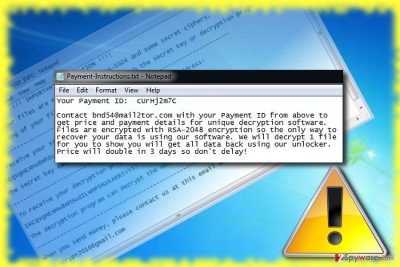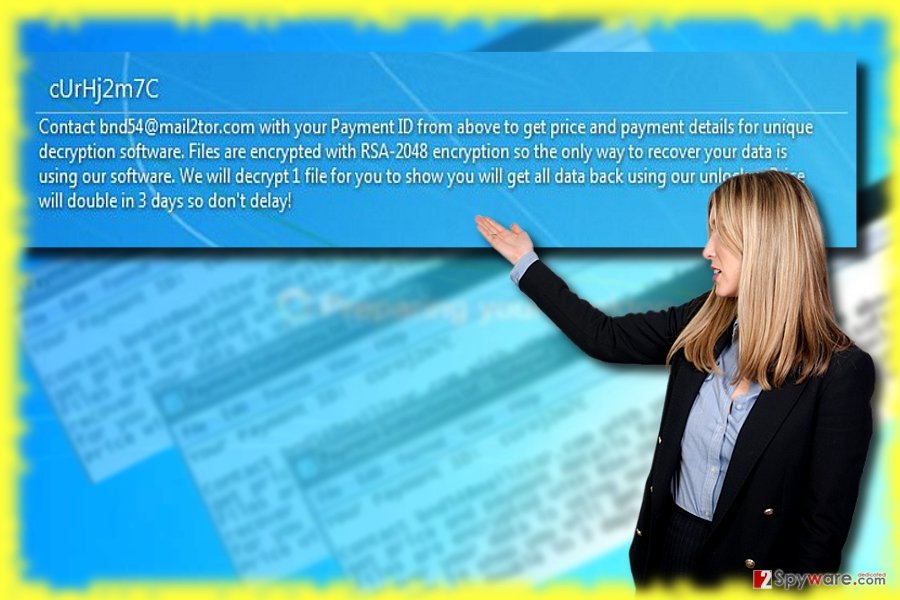Lockout ransomware / virus (Free Guide) - Free Instructions
Lockout virus Removal Guide
What is Lockout ransomware virus?
Lockout ransomware urges users to remit ransom within 3 days
Lockout virus operates as a file-encrypting threat encrypting files with RSA-2048 algorithm and attaches .lockout file extension. It has a preference for Windows 7 users. After infiltration, and during next reboot, the malware changes regular startup screen with its ransom note entitled as cUrHj2m7C, etc. Certainly, the title might be differ depending on each user’s IP. On the startup screen, it suggests contacting the penetrators via bnd54@mail2tor.com and provide an identification number. It urges affected users to pay the money within three days. When you log into the computer, Payment-isntructions.txt opens up with the same information[1]. Otherwise, the amount of money will double. They also offer to decrypt one file for free to earn users’ trust. Even in that case, it does not mean that the cyber criminals will return all files undamaged. Thus, instead, we recommend you to proceed to Lockout removal. For that purpose, FortectIntego or Malwarebytes might be of use.
One of the peculiar features of the virus is its ability to modify boot settings. Thus, this function enables the malware to present its message at startup. Furthermore, the malware behaves like ordinary malware. It connects to Command and Control server to coordinate the malware and its traffic. Due to this ability recovering private, decryption, the key is not an easy task as well. Interestingly, that the definitions by which Lockout malware is detected, relate to a notorious Win32Heur trojan, which was active three years ago, HEUR:Trojan.Win32.Generic. Interestingly, that another recently emerged threat, XData virus[2], which rampaged in Ukraine and managed to occupy four times more computers than WannaCry during the same period of time, also contains references to HEUR trojan. Thus, there is a probability that the scale of the inflicted damage by this malware might rocket. Therefore, the ransomware tends to behave as a screen locker malware as well. Though at the moment, there is no free decryption tool released of the malware yet, you should remove Lockout virus as soon as possible.
Distribution tendencies of the malware
The distribution techniques of Lockout ransomware hardly differ from the other samples of the ransomware family. The fact, that its executable trojan, which might be detected as
W32.eHeur.Malware08, hides in c.exe executable suggests that it may target users in disguise of fake updates, questionable scanners, browser add-ons as well as spam emails. Note that such emails may contain alerting information, such as urgent messages alarming user to review attached files. Such emails may contain typos or grammar mistakes which suggest the origin of the email. Thus, in order to limit the risk of Lockout hijack, install and keep updated anti-malware programs. Besides, it is crucial to retain vigilance while browsing the Web and installing new applications or enabling new features. 
Lockout elimination guide
Regarding the fact that this malware might be related to menacing XData virus, it is crucial to remove Lockout virus right away. For that purpose, security applications come in handy. Taking into account that this malware may block your computer screen, you may face Lockout removal problems. In that case, below guide will come in handy. Thus, below indicated guide would be of use. You may also disturb its process by ending its c.exe task in Task Manager.
Getting rid of Lockout virus. Follow these steps
Manual removal using Safe Mode
Important! →
Manual removal guide might be too complicated for regular computer users. It requires advanced IT knowledge to be performed correctly (if vital system files are removed or damaged, it might result in full Windows compromise), and it also might take hours to complete. Therefore, we highly advise using the automatic method provided above instead.
Step 1. Access Safe Mode with Networking
Manual malware removal should be best performed in the Safe Mode environment.
Windows 7 / Vista / XP
- Click Start > Shutdown > Restart > OK.
- When your computer becomes active, start pressing F8 button (if that does not work, try F2, F12, Del, etc. – it all depends on your motherboard model) multiple times until you see the Advanced Boot Options window.
- Select Safe Mode with Networking from the list.

Windows 10 / Windows 8
- Right-click on Start button and select Settings.

- Scroll down to pick Update & Security.

- On the left side of the window, pick Recovery.
- Now scroll down to find Advanced Startup section.
- Click Restart now.

- Select Troubleshoot.

- Go to Advanced options.

- Select Startup Settings.

- Press Restart.
- Now press 5 or click 5) Enable Safe Mode with Networking.

Step 2. Shut down suspicious processes
Windows Task Manager is a useful tool that shows all the processes running in the background. If malware is running a process, you need to shut it down:
- Press Ctrl + Shift + Esc on your keyboard to open Windows Task Manager.
- Click on More details.

- Scroll down to Background processes section, and look for anything suspicious.
- Right-click and select Open file location.

- Go back to the process, right-click and pick End Task.

- Delete the contents of the malicious folder.
Step 3. Check program Startup
- Press Ctrl + Shift + Esc on your keyboard to open Windows Task Manager.
- Go to Startup tab.
- Right-click on the suspicious program and pick Disable.

Step 4. Delete virus files
Malware-related files can be found in various places within your computer. Here are instructions that could help you find them:
- Type in Disk Cleanup in Windows search and press Enter.

- Select the drive you want to clean (C: is your main drive by default and is likely to be the one that has malicious files in).
- Scroll through the Files to delete list and select the following:
Temporary Internet Files
Downloads
Recycle Bin
Temporary files - Pick Clean up system files.

- You can also look for other malicious files hidden in the following folders (type these entries in Windows Search and press Enter):
%AppData%
%LocalAppData%
%ProgramData%
%WinDir%
After you are finished, reboot the PC in normal mode.
Remove Lockout using System Restore
You may opt for this method in case Safe Mode does not recover full control of the device. Then continue Lockout removal.
-
Step 1: Reboot your computer to Safe Mode with Command Prompt
Windows 7 / Vista / XP- Click Start → Shutdown → Restart → OK.
- When your computer becomes active, start pressing F8 multiple times until you see the Advanced Boot Options window.
-
Select Command Prompt from the list

Windows 10 / Windows 8- Press the Power button at the Windows login screen. Now press and hold Shift, which is on your keyboard, and click Restart..
- Now select Troubleshoot → Advanced options → Startup Settings and finally press Restart.
-
Once your computer becomes active, select Enable Safe Mode with Command Prompt in Startup Settings window.

-
Step 2: Restore your system files and settings
-
Once the Command Prompt window shows up, enter cd restore and click Enter.

-
Now type rstrui.exe and press Enter again..

-
When a new window shows up, click Next and select your restore point that is prior the infiltration of Lockout. After doing that, click Next.


-
Now click Yes to start system restore.

-
Once the Command Prompt window shows up, enter cd restore and click Enter.
Bonus: Recover your data
Guide which is presented above is supposed to help you remove Lockout from your computer. To recover your encrypted files, we recommend using a detailed guide prepared by 2-spyware.com security experts.If your files are encrypted by Lockout, you can use several methods to restore them:
Data Recovery Pro solution
In case you failed to make backup copies in advance, there is a chance that you may succeed in recovering some of the files with the help oof this program.
- Download Data Recovery Pro;
- Follow the steps of Data Recovery Setup and install the program on your computer;
- Launch it and scan your computer for files encrypted by Lockout ransomware;
- Restore them.
What is Windows Previous Versions feature?
In case, system restore was previously activated, you attempt to recover previously saved copies of your files. Note that this process takes time.
- Find an encrypted file you need to restore and right-click on it;
- Select “Properties” and go to “Previous versions” tab;
- Here, check each of available copies of the file in “Folder versions”. You should select the version you want to recover and click “Restore”.
ShadowExplorer and the files encrypted by Lockout malware
There is information that the malware deletes shadow volume copies, so it is likely that this program may recover some of the files by using this method.
- Download Shadow Explorer (http://shadowexplorer.com/);
- Follow a Shadow Explorer Setup Wizard and install this application on your computer;
- Launch the program and go through the drop down menu on the top left corner to select the disk of your encrypted data. Check what folders are there;
- Right-click on the folder you want to restore and select “Export”. You can also select where you want it to be stored.
What about Lockout Decrypter?
Let us warn you not to install the decryption software offered by the developers of this malware, you may only create more vulnerabilities for the malware to re-hijack the computer again.
Finally, you should always think about the protection of crypto-ransomwares. In order to protect your computer from Lockout and other ransomwares, use a reputable anti-spyware, such as FortectIntego, SpyHunter 5Combo Cleaner or Malwarebytes
How to prevent from getting ransomware
Stream videos without limitations, no matter where you are
There are multiple parties that could find out almost anything about you by checking your online activity. While this is highly unlikely, advertisers and tech companies are constantly tracking you online. The first step to privacy should be a secure browser that focuses on tracker reduction to a minimum.
Even if you employ a secure browser, you will not be able to access websites that are restricted due to local government laws or other reasons. In other words, you may not be able to stream Disney+ or US-based Netflix in some countries. To bypass these restrictions, you can employ a powerful Private Internet Access VPN, which provides dedicated servers for torrenting and streaming, not slowing you down in the process.
Data backups are important – recover your lost files
Ransomware is one of the biggest threats to personal data. Once it is executed on a machine, it launches a sophisticated encryption algorithm that locks all your files, although it does not destroy them. The most common misconception is that anti-malware software can return files to their previous states. This is not true, however, and data remains locked after the malicious payload is deleted.
While regular data backups are the only secure method to recover your files after a ransomware attack, tools such as Data Recovery Pro can also be effective and restore at least some of your lost data.
- ^ xXToffeeXx. New lockout ransomware uses the .Lockout extension and note Payment-Instructions.txt. Adds a custom legal notice with payment information.. Twittter. Online news.
- ^ Lily Hay Newman. Another Ransomware Nightmare Could Be Brewing in Ukraine. Wired. Cyber security news and tips.





















